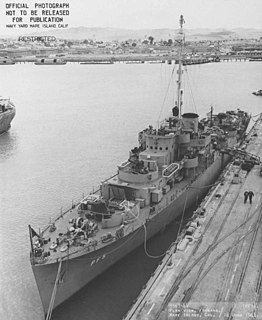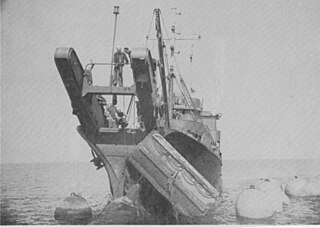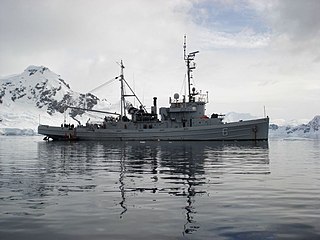
USS Hoquiam (PG-113/PF-5), a Tacoma-class patrol frigate in commission from 1944 to 1945 and from 1950 to 1951, she is the only ship of the United States Navy to be named for Hoquiam, Washington. She also served in the Soviet Navy as EK-13 and in the Republic of Korea Navy as ROKS Nae Tong (PF-65).

USS Etlah (YN-98/AN-79) was a Cohoes-class net laying ship built for the United States Navy during World War II. She was commissioned in April 1945 and spent her entire career in the Pacific Ocean. She was decommissioned in March 1947 and placed in reserve. She was recommissioned in August 1951 for Korean War service and remained active until May 1960. She was sold to the Dominican Republic in September 1976 as patrol vessel Cambiaso (P207). By 1994, Cambiaso had been removed from Dominican Navy service and hulked.

USS Rockford (PF-48), a Tacoma-class frigate in commission from 1944 to 1945, thus far has been the only ship of the United States Navy to be named for Rockford, Illinois. She later served in the Soviet Navy as EK-18 and in the Republic of Korea Navy as ROKS Apnokkang (62).

USS Poseidon (ARL-12) was one of 39 Achelous-class landing craft repair ships built for the United States Navy during World War II. Named for Poseidon, she was the only ship U.S. Naval vessel to bear the name.
USS Romulus (ARL-22) was laid down as a United States Navy LST-542-class tank landing ship but converted to one of 39 Achelous-class repair ships that were used for repairing landing craft during World War II. Named for Romulus, she was the only US Naval vessel to bear the name.
USS Ptarmigan (AM-376) was an Auk-class minesweeper acquired by the United States Navy for the dangerous task of removing mines from minefields laid in the water to prevent ships from passing. She was the only U.S. Navy ship named for the ptarmigan, a grouse with feathered feet, found in northern regions.
USS Signet (AM-302) was an Admirable-class minesweeper built for the United States Navy during World War II. She received four battle stars during World War II. She was decommissioned in December 1945 and placed in reserve. In February 1955, while still in reserve, her hull number was changed from AM-302 to MSF-302, but she was not reactivated. She was transferred to the Dominican Republic in January 1965 and renamed Tortuguero (BM455). She was employed as a patrol vessel in Dominican Navy service. Her pennant number was changed from BM455 to C455 in 1995. Tortuguero was stricken and hulked in 1997.
USS ATA-176 was an ATR-1-class rescue tug built for the United States Navy during World War II. She was laid down on 30 January 1944 and launched on 1 March as USS ATR-103, but was re-designated ATA-176 on 15 May. She was commissioned as USS ATA-176 on 19 August. She served in the U.S. Pacific Fleet during the war and was decommissioned on 30 June 1947. She was then manned with a civilian crew and placed in service, being renamed USNS Tonkawa (T-ATA-176) on 16 July 1948. Tonkawa, the first U.S. Navy vessel named for the Tonkawa, was taken out of service in 1956 and placed in reserve.
USS Satinleaf (AN-43/YN-62) was an Ailanthus-class net laying ship which served with the U.S. Navy in the western Pacific Ocean theatre of operations during World War II. Her career was without major incident, and she returned home safely after the war with two battle stars to her credit.

USS Teak (AN-35/YN-30) was an Aloe-class net laying ship which served with the U.S. Navy in the Pacific Ocean theatre of operations during World War II. She was assigned to serve the U.S. Pacific Fleet with her protective anti-submarine nets and earned two battle stars and other commendations for her bravery.

USS Sandalwood (YN-27/AN-32) was an Aloe-class net laying ship built for the United States Navy during World War II. She was later transferred to the French Navy as Luciole. She was stricken from the French Navy and sold to Malaysian owners, but her fate beyond that is unreported in secondary sources.
USS Mango (AN-24/YN-19) was an Aloe-class net laying ship which was assigned to serve the U.S. Navy during World War II with her protective anti-submarine nets.

USS Locust (YN-17/AN-22) was an Aloe-class net laying ship built for the United States Navy during World War II. She was later transferred to the French Navy as Locuste (A765). She was sold to Malaysian owners but sank after striking a reef off Cikobia Island, Fiji, on 30 July 1978. She was towing the former French ship Scorpion, which also sank.
USS Buckthorn (YN-9/AN-14) was an Aloe-class net laying ship built for the United States Navy during World War II. Originally ordered as USS Dogwood (YN-3), she was renamed and renumbered to Buckthorn (YN-9) before construction began in December 1940. She was launched in March 1941, and completed in September 1941. Placed in service at that time without being commissioned, she was commissioned in December 1942, and decommissioned in August 1947. She was placed in reserve in 1947 and scrapped in 1976.
USS Manayunk (YN-100/AN-81) was a Cohoes-class net laying ship which was assigned to protect United States Navy ships and harbors during World War II with her anti-submarine nets. Her World War II career was short lived as the war was ending, and she was placed in reserve and eventually struck by the Navy.
USS Oneota (YN-110/AN-85) was a Cohoes-class net laying ship which was assigned to protect United States Navy ships and harbors during World War II with her anti-submarine nets. Her World War II career was short due to the war coming to an end, but she was retained post-war sufficiently long to participate in atomic testing at Bikini Atoll.
USS Passaconaway (YN-111/AN-86) was a Cohoes-class net laying ship built for the United States Navy during World War II. She was commissioned in April 1945 and spent her entire career in the Pacific Ocean. She was decommissioned in December 1946 and placed in reserve. She was sold to the Dominican Republic in September 1976 as patrol vessel Separación (P208). As of 2007, Separación remained active in the Dominican Navy.
USS Passaconaway (YN-114/AN-86) – sometimes called USS Skakamaxon -- was a Cohoes-class net laying ship which was assigned to protect United States Navy ships and harbors during World War II with her anti-submarine nets. Her World War II career was short due to the war coming to an end, but, post-war, she continued salvage operations, including those at Bikini Atoll, before being struck from the Navy in 1947.

USS Crosley (APD-87) was a Crosley-class high speed transport that served in the United States Navy from 1944 to 1946.

ARA Suboficial Castillo (A-6) is an Abnaki-class tug/patrol boat of the Argentine Navy. She previously served in the US Navy as USS Takelma (ATF-113) from 1944 to 1992.









